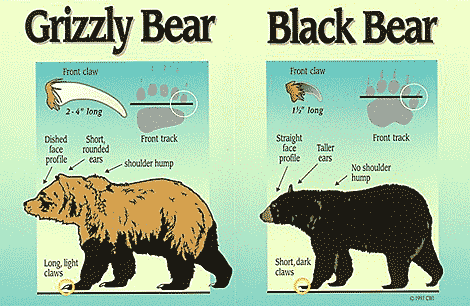Online Bear Baiting Clinic
Species Identification
Brown/grizzly bears are found in many areas of the state where black bear baiting is allowed. However, it is not legal to take brown bears at bait stations in all areas of the state. Determining what type of bear is at your bait station is very important.
Brown bears found inland are often called "grizzlies." We will not be discussing polar bears in this section.
At one time black bears were classified as furbearers. Now there is a growing appreciation for them as a meat and trophy animal. Black bears are very common and widely distributed. Black bear pelts make beautiful trophies if the bear is taken in early spring before it starts to rub off its thick winter coat. Bear baiters have the opportunity to be highly selective when harvesting a bear. Judging bears takes some practice, but understanding some basic characteristics will improve your odds of conducting a satisfying and legal hunt.
The color, or "phase," of a bear can vary from one individual to the next. For example, brown bears can range from near black or dark chocolate along the coast to the "blonde" phase often seen in interior grizzlies. Black bears can vary in color from jet black to white, but black, brown (or cinnamon), and blue (or glacier) are the three most common color phases. Black is the color encountered most frequently across the state, but brown or cinnamon bears are sometimes seen in Southcentral Alaska and on the Southeastern mainland. Cinnamon-phase black bears are also common in the Interior, so be sure to look at the other characteristics of any brown-colored bear at your station. The rare blue (or glacier) phase is most commonly found in the Yakutat area but it has also been reported in other parts of Alaska. Black bears often have brown muzzles and some have a patch of white hair on their chest.
Black bears are most easily distinguished from brown bears by their facial profile and claws: A black bear has a straight facial profile and their claws are sharply curved, seldom over 1 1/2" in length. The brown bear is usually larger, has a more prominent shoulder hump, a "dish"-shaped facial profile, and longer, straighter claws. As indicated above, color is not a reliable key in differentiating these bears because both species have several color phases.

